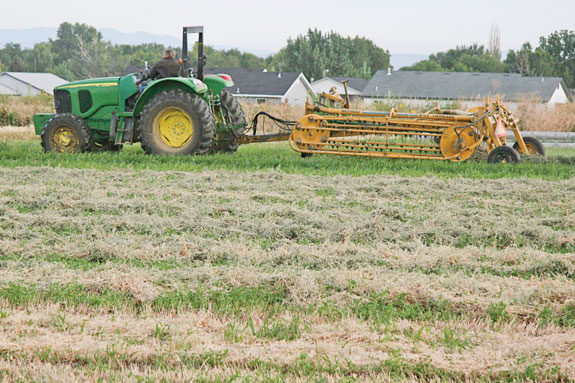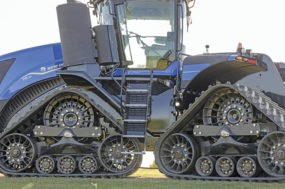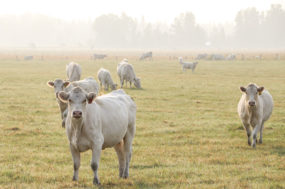The economic value of alfalfa losses increases from cutting to feeding.
Knowing the value of losses does not improve profits; however, realizing their magnitude should encourage you to be more conscientious when harvesting, storing and feeding the largest portion of ruminant animals’ diets.
Types of forage losses
Forage losses can be categorized as either harvest, storage or feeding losses. Harvest losses are either environmentally induced (respiration and rain damage) or machine-induced (e.g., raking, baling, chopping).
Many losses are visible such as leaf shatter during raking; however, invisible losses due to respiration and microbial activity also occur and eat away profits.
In addition, most forage losses are the most nutritious (highly digestible or protein) components of the plant. Because of this, nearly all losses not only reduce the amount available for animal consumption, but also reduce the quality of the feed.
It is the combination of reduced quantity and reduced quality which contributes to the economic loss.
Factors affecting forage losses
Each type of forage loss can have different factors which determine its magnitude and economic value. Rain damage is often out of your control; however, many times harvest sequencing can be adjusted based on the weather forecast.
Some producers cut forage based on date only, with no regard for weather forecasts, while others base all decisions on weather forecasts. Perhaps a balance between both approaches is best.
Farming is often referred to as legalized gambling. As such, beginning harvest with a slight or moderate chance of rain is very reasonable – especially since delayed cutting may increase maturity at harvest (thus lowering feed quality) and perhaps result in a missed cutting later in the year.
Rain loss (consisting of both leaf shatter and leaching) can vary from 5 to 40 percent depending upon rain amount, rainfall intensity and forage quality at the time of rain occurrence.
Obviously rain increases curing time; as a result, loss is increased due to the increased respiration.
Mowing-conditioning induces a loss of about 2 percent, most of which is leaves. Losses during other harvest operations such as raking, baling and chopping depend on the moisture content at the time of the operation as well as other factors.
The delay of a harvest operation can affect the amount of material removed from the field. With respect to harvest losses, wetter forage results in lower loss; however, wetter forage results in larger storage losses.
For best overall dry matter and nutrient recovery, alfalfa should be chopped for silage at nearly 65 percent moisture, raked when near 40 percent moisture and baled near 18 percent moisture.
Loss of dry matter during indoor hay storage depends on the moisture content of the hay as baled. Storage losses are 100 percent digestible plant material, thus the loss decreases the quality as well.
Loss of dry matter and deterioration of quality during outdoor storage of hay is much higher and nearly always warrants either plastic covering or a shed designated for hay storage.
Loss during silage storage typically ranges from 8 to 20 percent and depends on the type and condition of the structure, moisture content of the silage, duration of storage and several other factors.
Generally, larger silos result in less loss because of better packing and less surface area per ton of material stored.
Contrary to some opinions, properly managed bunker silos do not have larger storage loss than comparably sized tower silos. The key is proper management; bunker silos should be packed well and covered.
Condition of tower silos (sealed or not sealed) is important. As oxygen penetrates through the silo walls, respiration occurs, using up precious silage nutrients and dry matter.
Maintaining silos with tight-fitting doors and a good sealant will not only reduce losses, but will also increase the useful life of the structure.
Feeding loss can be reduced with smart feeding practices and a properly designed feedbunk. Have you looked at the floor or ground near your feedbunk or feeding stations to see if any feed is wasted?
You may be surprised to see how much feed is being used as a cushion underfoot.
Tips for reducing forage losses
- Maintain forage machinery in proper adjustment.
- Mow when there is little chance of rain but be willing to take risks so as to avoid overmature forage and missed cuttings.
- Lay the alfalfa in as wide a swath as possible – take advantage of free solar energy.
- Rake when the moisture content is near 40 percent, rake as few times as possible and rake as slowly as is feasible.
- Bale when moisture content is near 18 percent.
- Chop when moisture content is near 65 percent for concrete tower silos, 70 percent for bunker silos and 55 percent for steel tower silos.
- Store round bales inside or under a cover and off the ground.
- Maintain silos in good condition.
- Pack bunker silos well and cover them.
- Fill silos quickly.
- Use properly designed feedbunks and do not overfill them. FG
References omitted due to space but are available upon request.
PHOTO
Many losses are visible such as leaf shatter during raking; however, invisible losses due to respiration and microbial activity also occur and eat away profits. Photo by FG staff.












